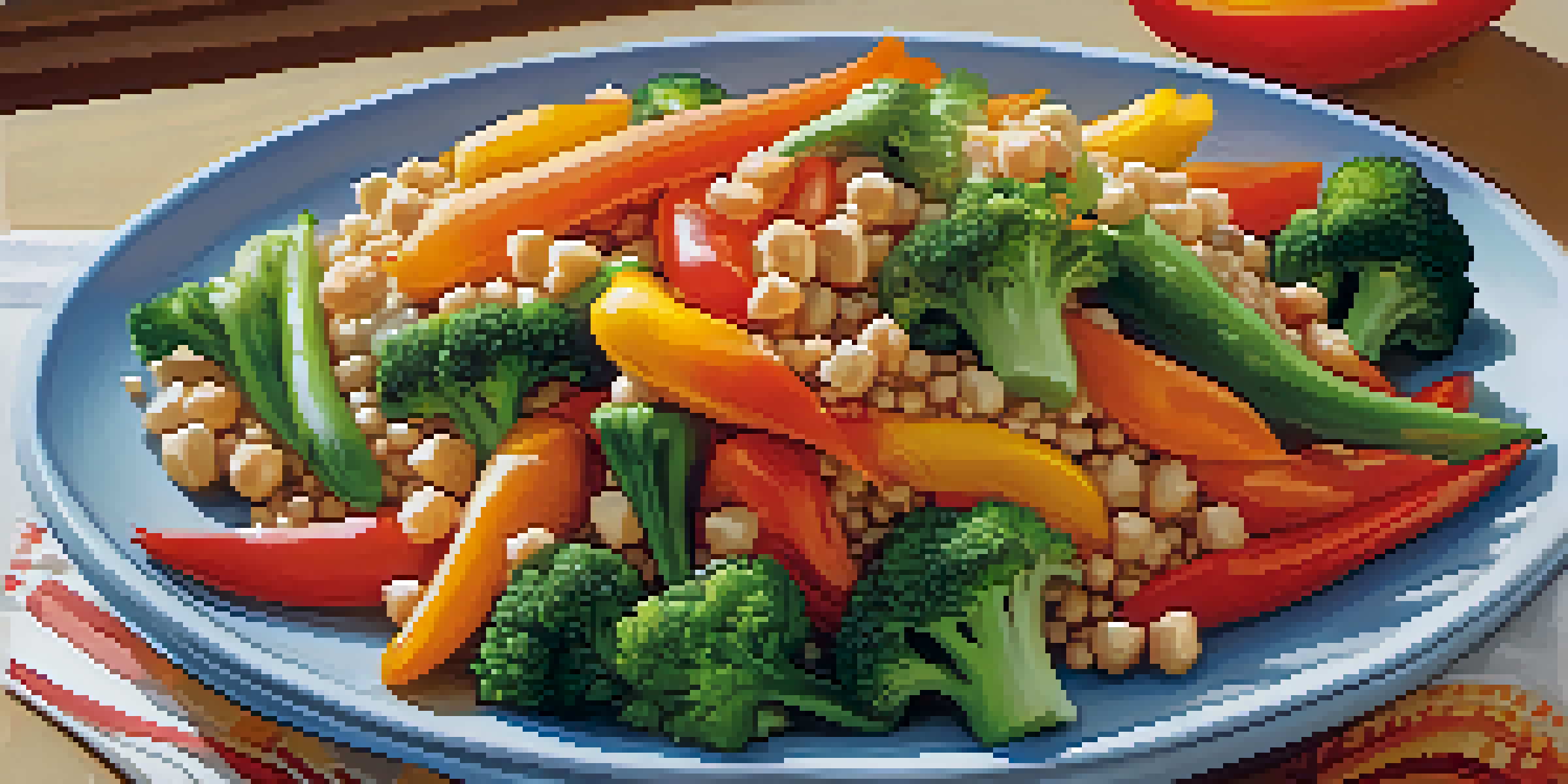How to Plan Balanced Vegetarian Meals for Kids

Understanding the Nutritional Needs of Growing Kids
Children are in a constant state of growth and development, which means their nutritional needs are quite specific. A balanced vegetarian diet can support this growth while ensuring they receive essential nutrients like protein, iron, and vitamins. It's important to understand that while kids can thrive on a vegetarian diet, careful planning is crucial to meet their dietary requirements.
Let food be thy medicine and medicine be thy food.
For instance, protein is vital for muscle development, and vegetarian sources include beans, lentils, tofu, and whole grains. Iron, often found in animal products, can be obtained from leafy greens, legumes, and fortified cereals. Pairing these foods with vitamin C-rich fruits can enhance iron absorption, making meals more effective nutritionally.
Ultimately, by understanding what nutrients your child needs, you can create meals that not only satisfy their hunger but also support their overall health and well-being.
Incorporating a Variety of Food Groups
A balanced vegetarian meal for kids should include a mix of food groups to ensure a well-rounded intake of nutrients. This means incorporating fruits, vegetables, grains, and protein sources into every meal. Variety not only keeps meals exciting but also helps cover a broader spectrum of vitamins and minerals.

For example, a colorful stir-fry with bell peppers, broccoli, and carrots served with brown rice and chickpeas can be both appealing and nutritious. You can even let your children help in choosing and preparing these foods, which makes them more likely to eat what they help create. Plus, involving them in the cooking process can spark their interest in healthy eating habits.
Nutritional Needs of Growing Kids
A balanced vegetarian diet is essential for children's growth, requiring careful planning to meet their specific nutritional needs.
By rotating different ingredients and cooking methods, you can keep meals fresh and enjoyable. This variety not only supports their nutritional needs but also fosters a positive attitude towards healthy eating.
Creative Ways to Sneak in Nutrients
Getting kids to eat their vegetables can sometimes feel like a battle, but there are clever ways to sneak in those essential nutrients. One effective method is to incorporate vegetables into dishes they already love. For example, adding spinach to smoothies or blending carrots into pasta sauce can make a big difference without a fuss.
The greatest wealth is health.
Another fun approach is to create veggie-based snacks, like zucchini muffins or cauliflower pizza crusts. Kids are often more open to trying new foods when they’re presented in a familiar or fun way. By making healthy foods appealing, you can help your child develop a taste for them over time.
Ultimately, the goal is to create a positive association with vegetables and other nutrient-dense foods. With a little creativity, you can make healthy eating enjoyable and exciting for your kids.
Planning Meals Together as a Family
Involving your children in meal planning can empower them and foster a sense of responsibility towards their food choices. Take time each week to sit down together and brainstorm meal ideas. This not only makes the process fun but also allows them to express their preferences and learn about nutrition.
As you plan, encourage them to choose a variety of foods from each food group. This can lead to discovering new favorites and can help them understand the importance of a balanced diet. You can even make a game out of it by selecting a 'theme' for the week, such as 'Mexican Night' with tacos and black beans.
Involving Kids in Meal Planning
Engaging children in meal planning fosters responsibility and helps them understand the importance of a balanced diet.
By making meal planning a family affair, you're teaching valuable lessons about nutrition and cooking while also creating lasting memories together.
Easy and Nutritious Vegetarian Meal Ideas
When it comes to vegetarian meals for kids, simplicity is key. Some easy ideas include veggie wraps filled with hummus, shredded carrots, and cucumber, or quinoa bowls topped with black beans, corn, and avocado. These meals are quick to prepare and can be customized to suit your child's taste.
Another great option is homemade veggie burgers made from beans and grains, served with whole-grain buns and a side of sweet potato fries. You can also try making colorful pasta salads with cherry tomatoes, peas, and a light vinaigrette. These dishes are not only nutritious but also visually appealing, making them more tempting for kids.
By keeping meals simple yet flavorful, you can ensure your kids are getting the nutrients they need without spending hours in the kitchen.
Understanding and Overcoming Picky Eating Habits
Picky eating is a common phase for many children, and it can pose a challenge when trying to plan balanced vegetarian meals. Understanding that this is a normal part of development can help you navigate these preferences with patience. Instead of forcing them to eat certain foods, try offering a variety of options and allowing them to choose what they want.
It can also help to introduce new foods alongside familiar favorites. For example, if your child loves pasta, try adding a new vegetable to their favorite sauce. Gradually introducing new flavors can make them less intimidating and encourage your child to try new things.
Overcoming Picky Eating Habits
Introducing new foods alongside familiar favorites and allowing choices can help children expand their palates and develop healthier eating habits.
Remember, persistence is key. It may take multiple exposures before a child accepts a new food, so keep offering it without pressure. Over time, their palate may expand, leading to more adventurous eating habits.
Maintaining a Balanced Diet Beyond the Plate
While planning meals is crucial, it's also important to consider your child's overall lifestyle. Encourage regular physical activity and provide opportunities for outdoor play, as these habits can enhance their overall health. A balanced diet goes hand-in-hand with an active lifestyle, fostering both physical and mental well-being.
Additionally, instill healthy eating habits by modeling good behavior. When children see their parents enjoying a variety of foods, they’re more likely to follow suit. Family meals can be a great time to connect and discuss nutrition, creating a positive atmosphere around eating.

Ultimately, a holistic approach that balances nutrition, physical activity, and healthy habits will set your child up for a lifetime of well-being, making vegetarian meals just one piece of the puzzle.